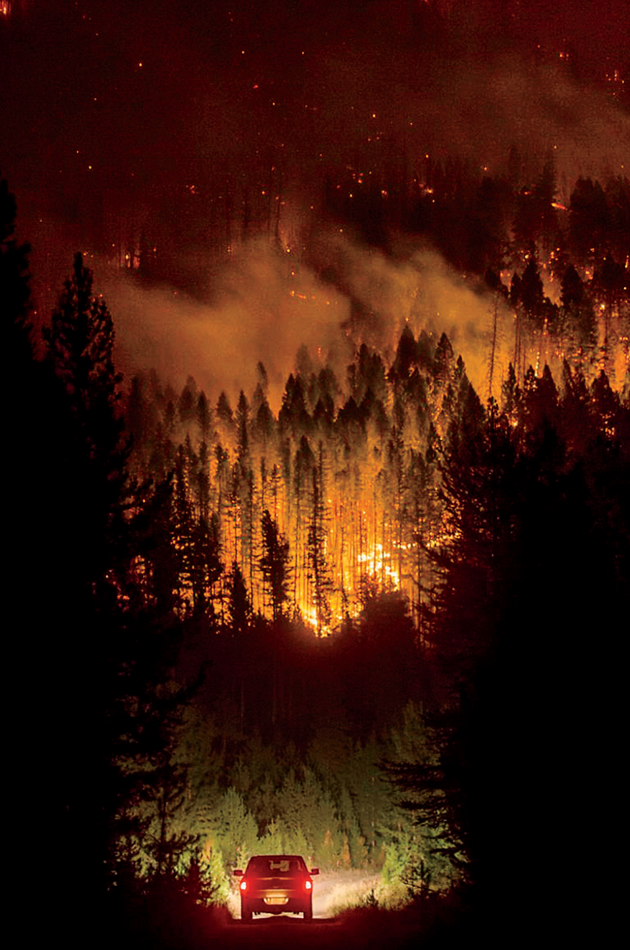On any given day last summer, the smoke-choked skies over Missoula, Montana, swarmed with an average of twenty-eight helicopters and eighteen fixed-wing craft, a blitz waged against Lolo Peak, Rice Ridge, and ninety-six other wildfires in the Lolo National Forest. On the ground, forty or fifty twenty-person handcrews were deployed, alongside hundreds of fire engines and bulldozers. In the battle against Rice Ridge alone, the Air Force, handcrews, loggers, dozers, parachutists, flacks, forecasters, and cooks amounted to some nine hundred people.
Rice Ridge was what is known as a mega-fire, a recently coined term for blazes that cover more than 100,000 acres. The West has always known forest fires, of course, but for much of the past century, they rarely got any bigger than 10,000 acres. No more. In 1988, a 250,000-acre anomaly, Canyon Creek, burned for months, roaring across a forty-mile stretch of Montana’s Bob Marshall Wilderness in a single night. A few decades on, that anomaly is becoming the norm. Rice Ridge, for its part, swept through 160,000 acres.
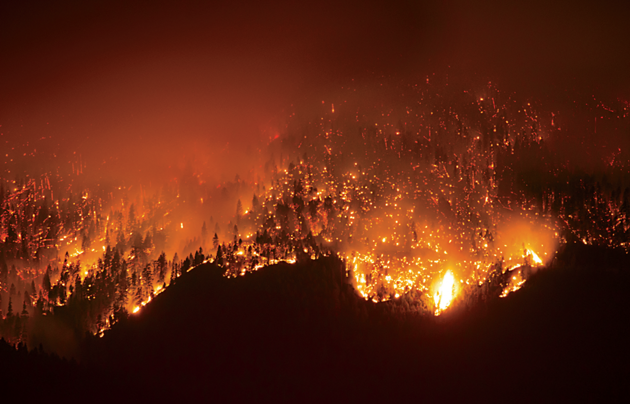
Photograph of Lolo Peak fire © Laura Verhaeghe
At this scale, the firefighting operation is run by an incident management team, a group of about thirty specialists drawn from a mix of state and federal agencies and trained in fields ranging from aviation to weather forecasting and accounting to public information. The management teams are ranked according to experience and ability, from type 3 (the least skilled) to type 1 (the most). The fiercest fires are assigned to type 1s. Teams take the name of their incident commander, the field general, and some of those names become recognizable, even illustrious, in the wildfire-fighting community. One such name is that of Greg Poncin, who is to fire commanders what Wyatt Earp was to federal marshals.
Poncin and I met last September at the Rice Ridge command center, near the town of Seeley Lake. The camp was a makeshift cluster of tents at the edge of town, the size of a middling suburban shopping mall. By the time I arrived, the flames had been snuffed out (by a weekend of snow and rain rather than the two months of firefighting) but yellow-shirted workers were busily stowing gear, and the big, military-grade wall tents—air-conditioned, hard-floored—still stood.
Poncin is trim, fit, and seems younger than his mid-fifties, especially in the rolled-brim baseball cap that covered his balding head. The cap—lettered northern rockies incident management team—was the only sign of a uniform. He was otherwise dressed in Montana office casual: green fleece pullover, hiking pants, boots. He was without swagger, soft-spoken, thoughtful, and measured.
Poncin had taken charge at Rice Ridge earlier that month. Previously, he and his team had been working another fire, Lolo Peak. That blaze had threatened thousands of homes, sweeping across the exposed flank of the Fuji-like mountain that dominates Missoula’s horizons. Like Rice Ridge, Lolo Peak was what’s sometimes known as a “project fire”: a protracted, months-long quagmire so stubborn that firefighters are forced to abandon any goal of extinguishing it and must settle for herding it to places where it will do the least damage.
The work comes at considerable cost. Lolo Peak’s tab ran to $48 million, and about $49 million were spent at Rice Ridge. And these are but two of the 71,499 wildfires that, combined, torched more than 10 million acres throughout the West last year. Congress now appropriates around $4 billion annually for battling wildfires, and billions more are spent by state and local governments. Yet even this drastically understates the true price. According to a 2017 study in the Proceedings of the National Academy of Sciences, “Other societal costs, including real-estate devaluation, emergency services, and post-fire rehabilitation total about thirty times the direct cost of firefighting.”
These astronomical sums are often assumed to be an unavoidable consequence of increasingly catastrophic fire seasons, which require an expensive array of technology and machines. But while Poncin acknowledged the usefulness of aircraft, bulldozers, and smoke jumpers, he steered my thinking away from the technical aspects of wildfire. “One of the things I have learned in my time is that large fire is a social issue,” he told me. “It involves biological processes. There’s a physical side of it, but it’s really a social issue.”
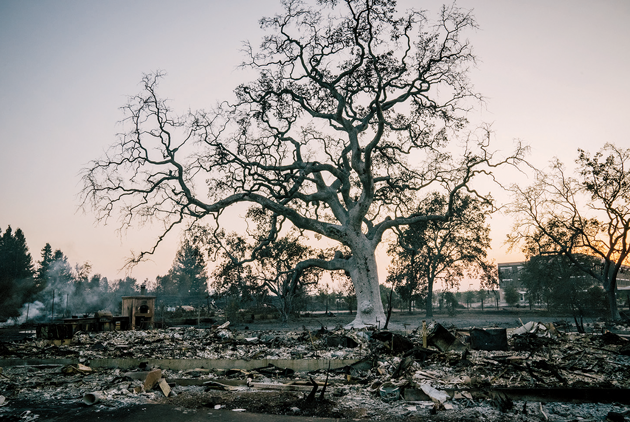
After a fire in Santa Rosa, California, October 2017 © Taliesin Gilkes-Bower/Realms Manifest
The complexity and diversity of the Western landscape would seem to offer endless ways to explain the increase in wildfires. Yet scientists, firefighters, and forest managers all agree that two factors can account for the catastrophic upheaval unfolding across nearly half the continent: climate change and a century-old policy of suppressing forest fires. The former is straightforward: Warmer temperatures deprive the high country of snowmelt earlier each year, drying out higher elevations. Bugs such as pine beetles survive winters that are growing milder, killing ever more trees. Dead trees burn more easily than live ones.
The second factor is expressed in what is known as the 10 am rule. After catastrophic fires spread from northern Idaho into Montana in 1910, headlines nationwide warned of an impending timber famine. The Forest Service responded by developing a policy stipulating that any forest fire that broke out was to be extinguished by ten the next morning. It worked, for a while, leaving most of the Rockies, the Sierras, and the Cascades choked with an abnormal glut of trees. Now, many decades later, from the stresses of global warming, but also from overcrowding, those trees, too, are dying.
Few people are better acquainted with the legacy of the 10 am rule than Curt McChesney. I sat with him at Pop’s café in Seeley Lake last October as an early winter storm swirled outside. These days, he works as a fishing guide, a fact made plain by a scattershot monologue about trout feeding patterns, currents, larval insect forms, and temperature gradients. Earlier in his life, though, McChesney had an entire career as a firefighter and smoke jumper, from his eighteenth birthday in 1970 until his retirement in 2005. He’s bright-eyed and affable, with a droopy gray mustache, an early-vintage senior citizen. In the world of firefighting, his nickname was Magpie, for the common and loquacious bird of the Northern Rockies.
McChesney’s grasp of the technical minutiae of firefighting is an introduction to a world almost no one ever really sees, although it’s in plain sight, even from the Pop’s parking lot. The forests that people live in, stroll through, and photograph mostly lie at low elevations. They’re populated by ponderosa pine, Douglas fir, and western larch, several of which, a few blocks north of where we sat, are three centuries old or more, their boles Brobdingnagian. At the less visible higher elevations, however, the forest looks different. Thanks to the 10 am rule, these heights are thick with stands of what every hiker, logger, or hunter knows as doghair: densely tangled, spindly little trees, mostly lodgepole pine and subalpine fir. The locals call it piss fir. Inaccessible and worthless to loggers, doghair rarely burns, even under natural conditions, because its elevation and density allow it to hold snow and moisture. But those rules have been rewritten, and now this is where many fires, including Lolo Peak, begin.
Before the 10 am rule, fire would regularly clear out the deadwood. But the span of fire-suppression policy has coincided with the natural life span of the doghair trees—about a hundred years. Now something like 80 percent of these trees are standing dead, McChesney said, skeletal, desiccated, and prone to what he called cigarette burns: given the impenetrable snarls of deadfall, a fire can appear to have been extinguished by an air tanker’s retardant, only to continue smoldering like a cigarette overnight, eventually creeping across the retardant line and setting the whole business ablaze the next afternoon.
Partly for this reason, Poncin told me, air wars are ineffective unless you can also put boots on the ground—smoke jumpers, or firefighters who rappel from helicopters—but the knots of deadfall and steep terrain can leave them stranded, surrounded by wildfire and miles from the nearest road. Furthermore, their work requires cutting trees, some of which are already dead, and some of which are the dying, hollowed-out trees the Forest Service calls hazard trees and old-time loggers call widow-makers. Three firefighters died in the fires around Missoula this past summer. Two of them, both teenagers, were crushed by falling trees.
Like any firefighter, McChesney has accumulated many stories of people at all levels pressuring him to send crews into peril. Sometimes directly, but more often not. “It’s always insinuated. You’ll hear in a meeting, ‘You need to do more. You need to do more to stop this fire in the beginning,’” he said. He has a standard response: “Do you have a son, a daughter, maybe a niece or nephew? Could you give me the name of two or three of those you are willing to give up so we can sacrifice them to do exactly what you want us to do?”
This very argument erupted in a contentious public meeting organized by the incident management team this past summer about the Rice Ridge fire. McChesney happened to be in the audience, attending as a civilian. He spoke up, talking the firefighter in charge into surrendering the microphone. “I counted up the other day how many friends—not acquaintances, friends—who died,” he told the crowd. “I have had eighteen friends who died doing exactly what you guys are doing. How many of you have lost eighteen friends in your daily lives?” The meeting’s tone became more civil.
John Maclean, though he’s a journalist and not a firefighter, could probably name eighteen off the top of his head. (Between 2000 and 2016, 299 wildland firefighters were killed on the job.) In recent years he has written a series of five books investigating tragic wildfires. Maclean seems to have inherited a niche family business—his father was Norman Maclean, the author of A River Runs Through It and Young Men and Fire, an account of the 1949 Mann Gulch fire in Montana, which killed thirteen firefighters. Five generations of Macleans have lived in a cabin at Seeley Lake, the same cabin that was featured in the novel and film. John still owns it and lives there, at least when wildfires have not forced evacuation.
He related to me the story of 1994’s South Canyon fire, in Colorado. A dispatcher failed to pass on a weather forecast predicting a fast-moving cold front with flame-fanning high winds—a blowup—and fourteen firefighters were killed. The incident taught firefighters that their most important tool is information, especially information about weather that can tell them how a fire might behave. The catastrophe forced a refinement in communications and forecasting to the point that firefighters can now expect “highly, highly accurate” predictions, almost to the minute, Maclean said. Yet global warming has made the effects of the predictable weather on fire highly unpredictable. And unpredictability creates unacceptable risk.
“There are times when you should just say no,” Maclean told me. “I don’t care what you tell these people about times to back off. Sometimes that happens, but when homes are at stake, it is the instinct of every real firefighter to fight harder. . . . You have to have that one seasoned, beat-up veteran who has lost some teeth, he’s got some scars on his ass, who says, ‘I’m in charge here. Sit down.’”
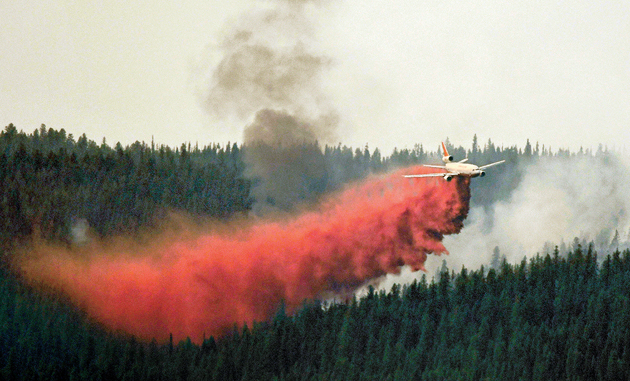
A converted DC-10 jumbo jet drops retardant on the Rice Ridge fire, near Seeley Lake, Montana © Tom Bauer.
One might wonder why the nation bothers to spend such vast sums of money, and sacrifice so many lives, fighting fires in the first place. The answer has little to do with forests, or forest health, or ecosystems, or saving Bambi’s mom from certain death. It has everything to do with what is inelegantly labeled the “wildland urban interface,” a term truncated into an acronym rhyming with “gooey” but nonetheless pronounced in serious conversation. It designates the edge of forests or other wild areas accessible enough for people to build houses. Such places host much of the West’s rapid growth in residential construction, despite the peril, which is offset by factors such as cheaper land, open space, wildlife, and distance from neighbors, building inspectors, and assorted regulators.
According to the scientists who wrote the National Academy paper,
Because of the people and property values at risk, WUI fires fundamentally change the tactics and cost of fire suppression as compared with fighting remote fires and account for as much as 95 percent of suppression costs.
Only about 15 percent of the total area burned in the West since 2000 has been in the WUI, though, meaning we spend the vast majority of our fire budget on a small portion of affected lands.
In other words, we as a nation pay ever-mounting bills to save a comparative handful of houses owned by people who against all sane advice choose to build in the path of catastrophe. Between 1990 and 2010, a period when we should have already known better, 2 million new homes were built in the interface. These homes don’t always appear to be on the edge of the wilderness. The entirety of Seeley Lake, a town with more than 1,700 permanent residents, is located in the WUI: the main drag with its tourist trade, the sawmill at the edge of town with its 130 workers, the cabins, trailers, frame houses, the high school, Cory’s Market, the American Legion hall, and Pop’s café.
Still, discussions of fire here tend to center around the Double Arrow Ranch, a subdivision dating from the Seventies that crawls up the wooded mountainside behind Poncin’s command center. It’s an incomprehensible maze of steep, narrow, winding roads leading to about four hundred summer cabins and year-round homes—some McMansions, some modest—rising higher into the denser forest, toward the doghair.
Through much of the summer, the residents, at least before they were evacuated, had a clear view of the Rice Ridge fire barely a mile away, a distance this fire had already proved it could cover in minutes. When I first drove into the Double Arrow last fall, the subdivision was still full of pumpkins—bright-orange, globular plastic tanks the size of a child’s backyard swimming pool, strategically placed to supply water to firefighters’ hoses. Poncin’s team had ensured that the fire never got that close. When he took charge, one of his first acts had been to ask someone to drive him through the Double Arrow. He called it “a nightmare”—a maze of dead ends, death traps for firefighters when flames block the only exit.
An hour southwest, development around the Bitterroot Valley harbors its own share of nightmares. The Bitterroot is a sprawl of haphazard development, strip malls, junkyards, and viciously conservative politics. The largest town in the clutter is Hamilton, and I passed three guns-and-ammo stores in half a mile.
I was in Hamilton to meet Byron Bonney, who worked out of a small building that could pass for a dentist’s office. At first glance the sixty-seven-year-old seemed to have made an impressive start on cussed-old-coot-hood—rail thin, wearing a full camouflage shirt and an elk-antler belt buckle. I thought he’d fit in fine at the ammo store across the way, but then I noticed a wall-mounted bulletin board behind his desk, tiled with eight-by-ten color prints of scenic wonders—mountains, canyons, rivers—and, dead center in the bottom row, a color portrait of Barack Obama.
Officially, Bonney ran a program making houses near forests more wildfire-resistant for the Bitter Root Resource Conservation and Development Area, a federally funded agency that usually worries about issues like erosion in rural areas. Bonney took this job in retirement, having spent an entire career fighting fire through more conventional means. (To this day, he freelances his way onto incident management teams during fire season, where he has often worked with Poncin.) His job now was to manage $8 million in federal grants that went toward subsidizing fire resistance, achieved by thinning trees around the houses of landowners who agreed to pay at least half the cost. The total bill for thinning a five-acre lot (a common size here) ran to about $5,000, he told me.
In 2016, Bonney’s work was put to the test. That year, the Roaring Lion fire swept down the flank of the Bitterroot Mountains into Hamilton and took out sixteen houses. Bonney’s program happened to have done its business on twenty houses within the fire’s path, so it was an opportunity to evaluate his effectiveness. Only eight of those twenty houses burned. “We did well,” he said.
He was serious. There are no sure bets in wildfire; one simply plays the odds, and eight of twenty burned, as unsuccessful as it sounds, beats twenty of twenty. For a few thousand dollars—what a homeowner might spend on kitchen countertops—thinning can improve the chances of survival for both the house and the firefighters. But despite the $8 million and the support of a community that has been plagued by wildfires for generations, Bonney estimates that he’s thinned only 5 percent of the land that needs to be treated, given the relentless advance into the wild. Many rural owners simply ignore prudent advice to fireproof their homes, just as they ignored prudent advice against building in the path of fire in the first place.
Under state law, all communities in Montana are supposed to develop fire-suppression strategies, though their plans tend to be pro forma and inadequate. Back in 2006, Bonney began mapping out a more comprehensive plan, which identified zones where nothing should be built, established priority areas for thinning and deliberately burning underbrush, and determined specifications for building with fireproof materials. After three years of work, he presented it to the Ravalli County Commissioners, a board dominated by newly elected firebrand conservatives. Arguing that Bonney’s plan represented an infringement on private property rights, they shot it down. Creeping socialism.
“We just sort of shook our heads,” said Bonney. But in the end, it wouldn’t have mattered all that much. Ravalli County lies between two parallel strips of wilderness, and from time to time, fire is going to come sweeping down regardless. The only uncertainty is how well communities will adapt to the process and how much the nation will pay when it happens.
“A fire-adapted community, to me, is a community that doesn’t exclude fire but has learned to live with it and not be scared every time there is a plume of smoke in the air,” Bonney said. “I think the landscape would look a lot different if we just threw our hands up and said we aren’t putting any fires out.”
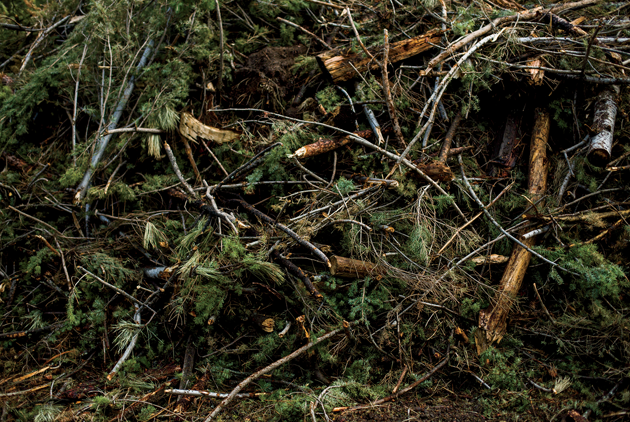
Trees cleared from a burn area after the Lolo Peak fire. Photographs from November 2017 by Celia Talbot Tobin
Not just different—better. In the late Sixties and Seventies, the Forest Service began experimenting with letting fires burn in limited regions of Western wilderness. In these areas, fires now tend to be less severe, produce less smoke, and feel less spectacular, almost to the point of being ignorable. The landscapes have begun to return to what they looked like before European settlement. Populations of threatened native species have thrived. All this, at close to zero expense to the US taxpayer.
Such policies, however, are toxic in the current political climate of the West. One can identify a conservative here simply by mentioning wildfire and waiting for the inevitable argument: “The Forest Service needs to put these fires out.” And the Forest Service does just that, as it has done for decades. (The agency, along with other federal entities and state and local crews, extinguishes about 90 percent of the many thousands of fires that occur each year on what is called initial attack, an all-out lights-and-sirens response the moment a fire is reported.) The conservatives who populate the canyons, gulches, and dead-end roads at the fringes of Western valleys are quick to put aside their customary laments about government overreach when it comes to spending billions to protect their own redoubts.
To firefighters who have faced the issue head-on, the irony is exquisite. In one neighborhood, the Lolo Peak fire was emphatically punctuated with confrontations between firefighters and open-carry advocates, the latter expressing their disapproval of the feds by packing pistols, displaying yard signs castigating Forest Service “liberals” and blaming the government for a natural disaster. They went as far as welcoming local and state firefighters while accosting federal employees, even though they all served under the same command.
Mike DeGrosky, the fire chief for Montana’s Department of Natural Resources and Conservation, told me that firefighters had to move a camp out of one ranching town at the eastern edge of the Bob Marshall after being harassed by locals. “There were people . . . who were aggressive and angry toward the fire people,” he said. They would drive into the camp to find firefighters trying to catch some sleep or doing jobs like repairing equipment in camp. “Get off your asses, go out there, put the fire out,” DeGrosky quoted them.
This political issue, like wildfire itself, is not a conundrum. It is easily solved. We know in detail what a set of zoning regulations governing house placement, thinning, building materials, access roads, and so forth might look like. All of these can be promulgated and enforced at the county level. But the federal government then needs to make fighting wildfires—a social process—subject to a social contract. Perhaps the feds should commit themselves to refusing to send in the troops to any county that has not taken such measures. Perhaps the solution to houses in the interface is to let them burn.
This might seem harsh in light of the example of California. Last year, nine thousand structures burned in the fires around Santa Rosa, and more than a thousand around Los Angeles. These were unprecedented numbers, and most of the victims committed no sin to merit this level of punishment. Nevertheless, a video clip from Santa Rosa makes a case for severe action. A reporter for NBC is doing a stand-up in front of a charred foundation that was once a home. The scene looks as you might expect, as long as you don’t look at the backdrop: a fringe of still-green trees. This image is common enough if you know what you’re looking for. Fire scientists have collections of such images, the aftermaths of fires that level entire subdivisions but leave the trees standing and green—the flames are hot enough to ignite building materials but not the surrounding flora. These aren’t forest fires; they’re subdivision fires, running house to house, fueled by bad choices in shingles.
About 30 percent of the houses that burned in one of the Santa Rosa fires, the Tubbs fire, were outside the WUI. Not in the woods. In cities. Urban. They were set alight by the burning of houses that were in the interface. Fire scientists speak of “ladder fuels,” which carry fire from one level to the next. In this case, thousands of irresponsibly built homes were the ladder fuel that destroyed houses situated in otherwise safe areas. There’s a rude and satisfying justice in burning down the house of someone who builds in the forest, but allowing his willful ignorance to destroy those of hundreds of more responsible neighbors is a travesty.
Back in Seeley Lake, it wasn’t that hard to uncover plenty of grousing and coffee-klatch controversy about fire, albeit nothing like the pistol-punctuated confrontations that cropped up in towns nearby. But Seeley Lake is, in the main, a reasonable place, maybe even approaching what Bonney suggested is needed for fire adaptation: people not scared of every puff of smoke. Bonney and Poncin were both right in asserting that this issue is ultimately a matter of social acclimation to and acceptance of wildfire. Yet they seemed to have in mind something like thinned woodlots, tin roofs, escape plans, and orderly public meetings, an emphasis on fire. I think there’s more to this, a deeper idea accessible not through an understanding of fire but through an understanding of wilderness.
A few weeks after snowfall doused the Rice Ridge fire, I returned to its edge, at a trailhead at Monture Creek. It is sacred ground to me, this particular trail leading into the wilderness, this trail from among the hundreds, for some reason, the setting for pivotal private moments, days I will remember on my deathbed as emblems of a life well lived. Many of my close encounters with mountain lions and grizzly bears happened here. The sight of a cougar calmly leveling its glowering gaze at you, then turning to saunter away, tail swinging, is indelible. Post-fire, it still seemed a place capable of inspiring awe and wonder.
Poncin’s crew had thinned a twenty-five-mile strip along a forest road, work that had been done with extraordinary skill and care to limit environmental damage. The biggest trees still stood. There was disturbance all the same, mostly in the miles of hard-edged, bulldozed swaths routinely made to create firebreaks, but the crews, loggers working under contract, had done the work as sensitively as they could.
And not just the dozer work. Seven thousand acres had been deliberately ignited by drip torches on the ground and little incendiary bombs that looked like Ping-Pong balls dropped from the air. Everything had been perfectly executed to control the burn, so it not only didn’t get out of hand but left what fire ecologists call a mosaic. About half the vegetation in the area was unburned and alive. This was obvious from a ridgetop that autumn day as the larch, the only conifer here with fall color, had turned its signature iridescent yellow-gold. Spring would green this canyon with life next year, just like any other.
Fire happened here, but the landscape afterward looked not so much like the result of firefighting as it resembled the very prescription we have for preventing future fires: thinned trees as a result of a controlled burn. Poncin’s crews had fought fire in a way that helped guide the landscape back to presettlement conditions, when it was naturally shaped by fire. People who say the Forest Service needs to put out fires are missing an unavoidable truth: it doesn’t matter. Put them out this year, and they will burn the next, hotter and angrier.
Everybody where I live has an opinion about wildfire, and it usually boils down to personal preference about the nature of the landscape: Green trees. Clean water. Charismatic megafauna. Logs for mills. Peace and predictability. Above all—and we all agree on this—no smoke in the air. But it doesn’t matter now what any of us wants. That’s the point, why fire is so valuable to our collective education. It announces the enormity of the consequences of climate change. Life will never be the same again. None of us will get what we want. Fire will come. Houses will burn. People will die.
Wilderness has a better grasp of global warming than we do. We humans are informed by instruments, computers, satellites, and sensors roaming the globe, telling us epochal upheaval is under way. But every functioning ecosystem, every living array of biological complexity, has even more adept sensors. The difference between the human and the wild’s grasp of the matter is the denial. Wilderness has no reasoning, no wishes, no preferences. Instead, it deploys death and fire to prepare the way for whatever is to come.

